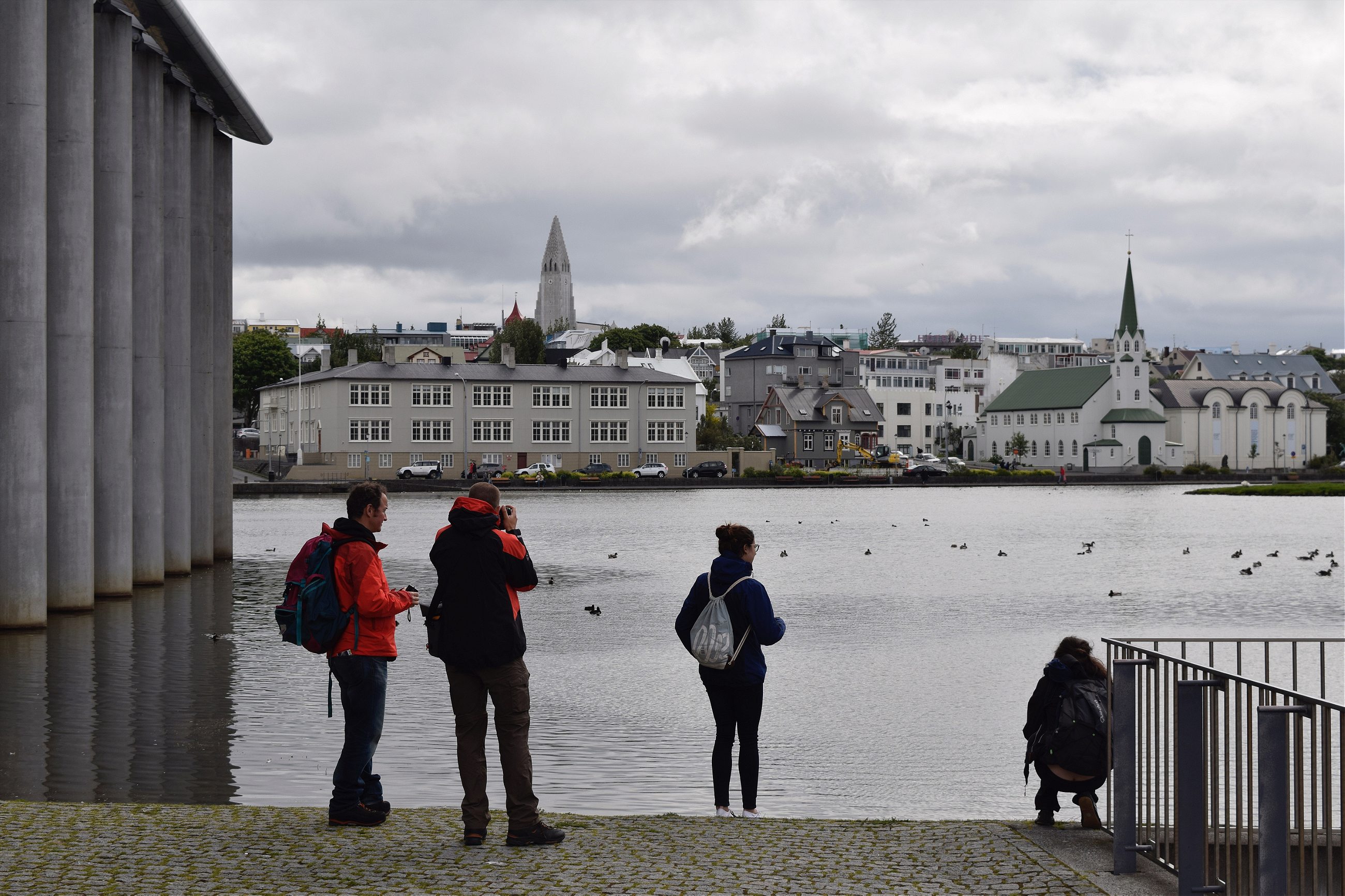Young Icelanders are using a satirical religion to protest the lasting ties between church and state on the island.
The elders have been called con artists, tax evaders, and heroes. But they might best be described as “millennials.” They are young and ambitious, they don’t own cars, and the best way of reaching them is Snapchat. When I met a few of the elders not long ago on a surprisingly sunny afternoon at a coffee shop near their apartment, one excitedly pointed out a new affordable grocery store that opened down the street. As we spoke, church bells from a more traditional faith ironically tolled nearby.
I’m with the leaders of Zuism, one of Iceland’s newest religions. Although its numbers still pale in comparison to the Lutheran state church, it is fast becoming one of the country’s largest faiths. Followers say it is an offshoot of Sumerian beliefs, a nature-worshipping religion that evolved in Mesopotamia more than 5,000 years ago. But the group’s elders, as they call themselves, make clear that there is nothing truly religious about Zuism. Instead, it might be more accurately described as an anti-religion—and as a protest of Iceland’s parish tax, which has drawn the ire of many as a growing number of Icelanders turn away from the church.
Regardless of whether one is a member of a registered religion or not, all Icelanders pay a tax that amounts to about $80 per year, which is distributed to religious groups based on their membership. There’s no way to opt-out of paying the tax, but Zuist elders are promising to refund the parish taxes of their members, effectively acting as an opt-out within the system. Gunnhildur Gunnarsdóttir, a 26-year-old elder who recently graduated university with a degree in psychology, described the parish tax as akin to having to pay an “atheist tax.” Many Icelanders seem to agree; more than 3,000 people joined the Zuist ranks in the space of just two days last December.
Since Iceland’s 2008 financial collapse, there has been widespread distrust of traditional institutions
Zuism was created in 2013, two years before the current elders became involved, when Icelandic laws were relaxed to recognize a wider variety of religious organization. In fact, only one of Zuism’s current leaders—Ísak Ólafsson, its “high priest—was a member of the religion before last year. “He only joined because he was frustrated with the system,” says Sveinn Þórhallsson, a 29-year-old computer scientist and Zuist elder. If someone was going to be getting his money, Ólafsson thought it might as well be a group of young troublemakers rather than the church or state. Since Iceland’s massive financial collapse in 2008, there has been widespread distrust of traditional institutions, spurring acts of protests by Icelanders such as Ólafsson and the other Zuists.
Last year, when the Icelandic government noticed that the previous group of Zuists weren’t active, Þórhallsson says they threatened to deregister the religion. “That’s where we stepped in,” he says. The current elders launched a campaign last year to encourage young Icelanders to join, but they weren’t expecting it to be so successful. “At first it was like, maybe we’ll get our 5,000 krónur or whatever it is and buy beer for one night,” Gunnarsdóttir says. “But then we saw that we could give people in our religion the opportunity that we never had, which is to get the money paid back.”

In other countries, the emergence of Zuism might not have warranted a second glance; dozens of satirical religions have cropped up in recent years, from Pastafarianism to Dudeism. Most of these groups limit their aims to poking fun at the religious establishment. But in Iceland, where the most dominant building on the skyline of its capital is Hallgrímskirkja, an imposing 73-meter concrete church, the persisting connections between church and state make Zuism a clever form of protest.
The Evangelical Lutheran Church of Iceland still receives state support, and the Icelandic government pays the salaries of Lutheran pastors. “The national church, they use their numbers to say and do all sorts of things,” Þórhallsson says. More than 70 percent of the country’s barely 330,000 citizens are registered with the state church, but Þórhallsson points out that this is because Icelanders are registered at birth with the religion of their parents, and most people don’t bother to deregister.
Lutheran churches dot the Icelandic countryside, appearing along the coast wherever there are people. They’re tiny, often serving parishes of just a few dozen souls, and they make great pit stops during road trips around the island. On a recent weekend, I drove out to Strandarkirkja, a quaint church that looks south over open ocean. It was once one of the richest churches in Iceland, but now it only hosts bi-weekly services during the summer, so curious travelers can climb the bell tower and try their hands on the organ.
The decline of churches like Strandarkirkja reflects a trend away from religion in Iceland. A poll this year found that fewer than half of Icelanders consider themselves religious, and 72 percent of respondents said they were in favor of the separation of church and state.

But for pastors such as Gunnlauger Stefánsson, the church continues to be an important force in Icelandic society. “The church is such an integrated part of society that people in their daily lives, they are possibly not aware of it, but it is a part of their culture,” Stefánsson says. He tells me that although most Icelanders might not regularly go to church, the majority of ceremonies such as marriages and burials still take place in the Lutheran church.
Stefánsson also rejects the idea that the church and state continue to be connected in Iceland. “Today, the church is completely independent from the state,” he says. “There is one part of this legislation that the state formally pays the salary of the pastors, but it is based on an agreement between church and state—an independent agreement.”
Despite Stefánsson’s claims about the religiosity of Icelanders, it’s hard to deny a trend towards secularism in Icelandic society. At the forefront of this trend is Siðmennt, known in English as the Icelandic Ethical Humanist Association, which has been advocating for the separation of church and state since 1990. Lobbying by members of Siðmennt resulted in changes to Icelandic law in 2013 that allowed other religions such as Zuism to become registered.
“I think that what Zuists did, they picked up on what we have been talking about over the past 10 years, or 15 years,” says Bjarni Jónsson, the managing director of Siðmennt. “That the state should not register people, their religion, and that secondly the state should not spend taxpayers’ money to fund religious organizations.”

When the law changed in 2013 to include “life stance” groups such as Siðmennt alongside religious groups, it was after more than ten years of lobbying by Jónsson and two unsuccessful attempts to register Siðmennt. In 2008, Jónsson was finally promised that the issue would be discussed by parliament that fall.
But before that could happen, the day prior to the matter being tabled in parliament, Iceland experienced the largest banking collapse of any country in history. “Small matters such as this one were put aside,” Jónsson tells me. What followed was a major restructuring of financial institutions and, perhaps more noticeably beyond the island, massive protests by Icelanders calling for a new government and a new constitution.
In the wake of the collapse, Iceland’s first center-left government was elected, and the country’s new Minister of the Interior again brought Siðmennt’s case before parliament. On January 13, 2013, Bjarni says the Icelandic parliament finally agreed upon changes to the law that allowed groups such as Siðmennt and Zuism to register as religious organizations.
Icelanders have taken to the streets a number of times since the financial collapse. Most recently, the largest protests in the country’s history triggered early parliamentary elections after it was revealed Iceland’s prime minister was connected to the Panama Papers leak. Zuism is just the latest action some Icelanders have taken to express their discontent with traditional institutions, right up to the highest levels of government.
No, I don’t want to hear some priest tell me what to do as a politician
When Birgitta Jónsdóttir was first elected to Iceland’s parliament in the elections immediately after the collapse, she tells me she didn’t realize the first thing on her agenda would be to visit a church with the Bishop of Iceland. In fact, Iceland’s parliament is directly across a narrow street from the Reykjavík Cathedral—a symbolic representation of the close ties between church and state.
“I thought, ‘No, I don’t want to hear some priest tell me what to do as a politician,’” Jónsdóttir says. “We criticize, for example, a lot of Muslim countries for having religion and politics mixed, so what’s the difference?” She’s also quick to point out that when Iceland’s parliament began in the year 930, most people on the island practiced pagan beliefs. Christianity wasn’t widely adopted until nearly 100 years later.
Jónsdóttir is the leader of the Pirate Party, an anti-establishment party that has been polling in first place just a few months ahead of Iceland’s 2016 parliamentary elections. Although she is Buddhist, Jónsdóttir says she joined Zuism to support the objectives of its leaders. “That was a beautiful direct action,” she says about Zuism. “I don’t even expect to get my money back—it’s not about that. It’s about the issues they were raising.”

There are signs of the church’s persisting dominance wherever you look on this island. In Reykjavík, Hallgrímskirkja can be seen from all over the city, and visitors use its spire to guide them through the winding streets. Even those who support the motives of Zuists have difficulty taking the revival of Sumerian religion in the North Atlantic too seriously. “Zuism is a joke,” Jónsdóttir says. “And it’s a beautiful joke.”
But the young Zuist elders insist they have some serious goals. As more members join, they hope the government will consider reforms to its other religious policies, including abolishing the automatic registration of infants in the religion of their parents and removing the clause in the Icelandic constitution that makes the Lutheran church the country’s state church.
“Icelandic people are really thinking about freedom,” says Gunnarsdóttir when asked if she sees any connections between the rise of Zuism and other social movements in Iceland. She grins when asked about her response to people who dismiss Zuism as just a harmless joke. “The only thing we can say to that is that the Icelandic government is paying 30 million krónur to the Zuism religion,” she says. “It’s an expensive joke.”